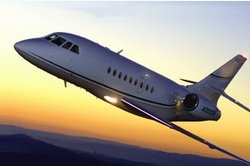Tue, Nov 09, 2010
Engineering Assisted Field Approval Completed By Universal
Avionics
The first Wide Area Augmentation System (WAAS) Flight Management
System (FMS) installation in a Dassault Falcon 2000 aircraft has
been completed by Universal Avionics authorized dealer Jet Aviation
St. Louis. The installation replaced existing Universal Avionics
FMSs with dual UNS-1Ew WAAS/SBAS-FMS and includes approval for
Localizer Performance with Vertical (LPV) approach
capabilities.

Falcon 2000 File Photo
Certification approval for the installation was completed by way
of an Engineering Assisted Field Approval, an FAA certification
process that allows Universal Avionics WAAS/SBAS-FMS to be approved
with LPV approach capabilities under a field approval (337)
process. Using the Engineering Assisted Field Approval Process,
operators of approved Universal Avionics FMSs may upgrade to WAAS
and LPV capability during regular aircraft maintenance, as did this
Falcon 2000 operator.
"Jet Aviation St. Louis and Universal Avionics partnered to
deliver a first-of-its-kind system that allows this operator to
access smaller airports with LPV approaches," said Skip Madsen,
vice president MRO for Jet Aviation. "Together with Universal
Avionics, Jet Aviation St. Louis put its experience and engineering
capability into play and the upgrade went smoothly."

The upgrade package replaced the UNS-1C FMSs with UNS-1Ew
WAAS/SBAS-FMSs, which provides the ability to fly RNAV (GPS)
approach procedures down to LPV descent minima. Localizer with
Vertical (LPV) approach procedures take advantage of the precision
of WAAS GPS for both lateral and vertical guidance during the
approach segment. Aircraft operators with WAAS GPS avionics can fly
with RNP-like accuracy of 0.3 NM and minima as low as 200 ft with
½ mile visibility for "ILS-like" capability at airports
without ILS navaids. Greater airport accessibility and improved
safety in poor weather conditions are just some of the other
advantages of utilizing Satellite-Based Augmentation System (SBAS)
guidance.
More News
From 2023 (YouTube Edition): "Ain’t Your Daddy’s Super Cub”—Don Wade Co-owned by Don and Ron Wade—the former of Don’s Dream Machines, a storied >[...]
Pilot-Rated Passenger Reported That The Pilot Did Not Adequately “Round Out” The Landing Flare And The Airplane Bounced And Yawed To The Right Analysis: The pilot state>[...]
Dead Reckoning Dead reckoning, as applied to flying, is the navigation of an airplane solely by means of computations based on airspeed, course, heading, wind direction, and speed,>[...]
Aero Linx: Lake Amphibian Club This website is created and sponsored by the Lake Amphibian Club, to help spread the word about these wonderful, versatile amphibians that can land j>[...]
“I am deeply honored to be sworn in as NASA administrator. NASA’s mission is as imperative and urgent as ever — to push the boundaries of human exploration, ignit>[...]
 Classic Aero-TV: In Praise of Alabamas Patriot Aircraft USA
Classic Aero-TV: In Praise of Alabamas Patriot Aircraft USA NTSB Final Report: Cirrus Design Corp SR22
NTSB Final Report: Cirrus Design Corp SR22 ANN's Daily Aero-Term (12.21.25): Dead Reckoning
ANN's Daily Aero-Term (12.21.25): Dead Reckoning ANN's Daily Aero-Linx (12.21.25)
ANN's Daily Aero-Linx (12.21.25) Aero-News: Quote of the Day (12.21.25)
Aero-News: Quote of the Day (12.21.25)




